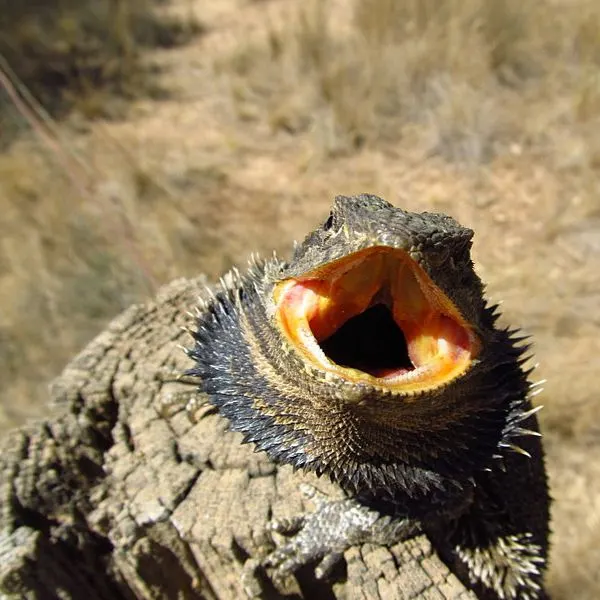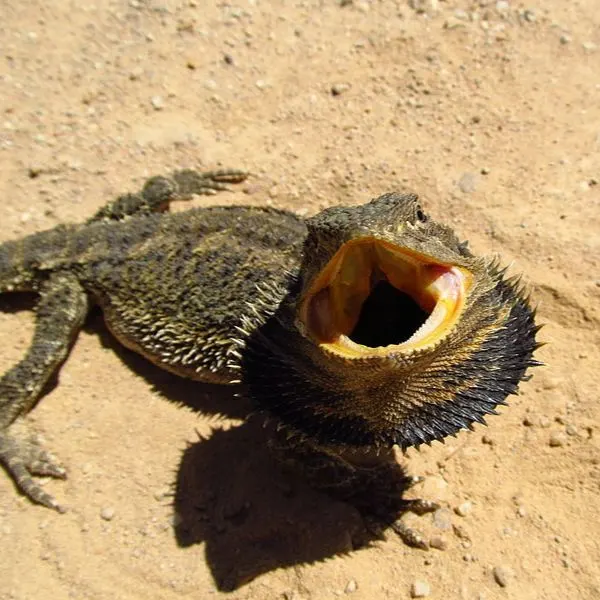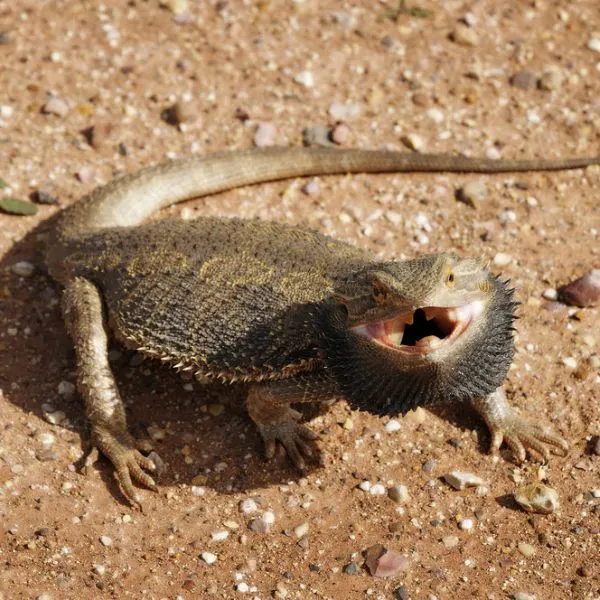Bearded dragons are known for being the calm, cool, and collected a bunch of the reptile family, but that doesn’t mean they can’t be aggressive. An aggressive bearded dragon might cause a bearded dragon owner to worry.
On the whole, bearded dragons are a rather docile bunch but there are several reasons that your once calm and level-headed beardie can become a Mr. Hyde.
Some of the main reasons for sudden aggression in bearded dragons could be stress, illness, hunger, prior abuse, or environmental factors. We will be going over several reasons your bearded dragon could be showing signs of aggression, and how to handle them.
If your bearded dragon has become aggressive, the most important thing you can do is to remain calm. If both the pet and owner are stressed, then neither can solve the problem.
Read on below and find out why your beardie could be aggressive and how to best handle the situation.
Table of Contents
- Aggressive Behaviors
- Causes of Aggression
- Dealing with Aggression
- Taming an Aggressive Dragon
- Conclusion
What Do Aggressive Behaviors Look Like?

First off it is important to define what constitutes aggressive behavior in bearded dragons. A bearded dragon’s aggressive behavior can vary depending on different personalities, and each one can display aggressive behavior in different ways.
Here are the most common displays of aggression that bearded dragons can exhibit.
Black Beard
No, your beardie isn’t going to threaten you with walking the plank-like the infamous pirate, but most bearded dragons display aggression by puffing out their chin and making it look black. This could be accompanied by gaping—opening its mouth very wide.
Showing off the black beard is usually a way they display dominance, aggression, or they are saying, “this is my territory, back off.” Bearded dragons will also puff out their beards if they feel threatened.
They are trying to look bigger, meaner, and more dangerous with the dark colors and larger stature. Don’t try to pick them up when showing off their black beards.
Here’s an example of an aggressive beardie ready to strike exhibiting its black beard:
Head Bobbing
Another way bearded dragons show off dominance or aggression is by head bobbing. This is quite common in adolescents, especially if they see their reflection or are paired up with other beardies.
They will quickly nod their heads a few times in a row, this is called head bobbing. Females may head bob to show submission and acceptance to a male during the breeding season.
Here’s an example of beardie head-bobbing:
Flattening Out
In a similar behavior to showing their beards, bearded dragons will often flatten themselves out if they are frightened or feel threatened. Again, they attempt to make themselves look bigger and more menacing when they spread their abdomens out.
Hissing
If bearded dragons are feeling particularly nasty or anxious, they can hiss just like an angry or threatened snake. They use this behavior to attempt to frighten away threats.
This might get a bearded dragon hiss out of them, chances are it is either very frightening, or it is protecting its territory.
Biting
Bearded dragons can bite as well. They have two rows of very sharp teeth designed to hold on to wriggling insects and tear vegetation.
A bearded dragon can bite if it truly feels frightened or threatened, or it could be an accidental bite from a hungry beardie.
Bearded Dragons will recognize the difference between fingers and food, but sometimes an overzealous eater might accidentally latch onto your fingers. To prevent this from happening, you can use feeding tongs, especially if you are trying to feed them small, wiggling insects.
Though bearded dragon bites can hurt and break the skin, the most important thing to do if a bearded dragon bites you is to remain calm.
I know that’s hard to do when you have tiny, sharp teeth grabbing onto your flesh, but to prevent harm to the beardie, and from inflicting more harm to yourself don’t try to pull away. Whether from aggression or hunger, the bearded dragon will soon let go as long as you remain still and calm.
Be sure to clean and disinfect the bearded dragon bite area immediately after. If you were bitten for no apparent reason, then leave him alone for at least the rest of the day. He may need time to calm down.
Running Away
Oftentimes when a bearded dragon does not want to be handled, they will run away. If this happens while you are trying to show her some affection, maybe she isn’t feeling particularly snuggly at that moment. If she is being avoidant, then leave her be for a little while and try again later.
Tail Whipping
Tail-whipping is rarer than the others. This bearded dragon behavior is not as powerful as Iguanas, who are the kings of tail whipping.
Mostly a bearded dragon will puff out or turn its beards black when showing signs of stress or aggression, but if it is swinging its tail at you, it also means, “get back, I don’t feel like being handled right now.”
What Can Cause Aggression?

Alright, now that we have discussed the most common aggressive behaviors in bearded dragons, let’s go over what could be causing your beardie’s temper tantrum.
Stress
Bearded dragons thrive in calm, quiet environments. If something has changed, there are constant loud noises that put him on edge, or maybe you had to move to a different location, it could be feeling stressed.
Your beardie could be acting out aggressively because of the stressors. Take a look and see if something is stressing your dragon out and take corrective measures.
Prior Abuse
Is your beardie a rescue? Is he constantly on edge, or angry?
It could have been abused before you took over. If that is the case, eventually, with proper care and patience your angry bearded dragon will learn to trust and love you.
Shedding
The process of shedding can be a difficult time for your bearded dragon. You can help the process by misting her while she is shedding or giving her a soak in the bath which will help to soften the shed.
Whatever you do, don’t tug or pull on the shedding skin because you could cause pain and tear the skin; instead let the skin come off on its own.
Illness
If your bearded dragon is sick, he or she will likely not want to be handled and show off signs of aggression. Signs of sickness include abnormal poops, mucus from the vent or face, skin discoloration, loss of weight, loss of appetite, lethargy, and vomiting.
If you suspect your dragon is coming down with an illness, contact your vet immediately.
Fright
Loud noises, sudden movements, or even powerful scents like that new perfume you’re trying out could cause your beardie to become frightened and display aggressive behavior. Be aware of your movements when approaching your dragon, come in slowly from the side, not from overhead or directly in front of it, as this could be seen as threatening behavior on your part.
Hunger
It happens to the best of us; we get busy, there are just so many things in the day to do and we miss a meal. Before you know it, you’re hangry. I know I’ve been guilty of it, it’s no different with bearded dragons.
Hunger can make them aggressive and act out.
Tank is Too Small
When there isn’t enough room for your beardie to move around or get enough exercise, they can become aggressive. The minimum tank size for a healthy adult bearded dragon should be 50 gallons, while 75 and larger is ideal.
Too small of an enclosure will cause your beardie to not get enough exercise, could limit the correct amount of light and heat, causing territorial aggression.
Doesn’t Like Tank Mates
Bearded dragons are loners. They like to be the center of your attention, get all the food, and hog the basking spot all for themselves.
If you introduce another beardie into the enclosure, he now has to share all these things. Being too crowded, or simply having to share could be making your beardie irritable.
Mating Season
Hormones are flowing, changes are happening, and that female beardie isn’t showing the least amount of interest in the male dragon. Yeah, he’s feeling the pressure and could be releasing that steam in the form of aggression.
Pain
Pain is definitely a reason for your bearded dragon to show signs of aggression. Inspect your dragon for any signs of injury.
It could have gotten a toe or its tail stuck in something, or if there are other tank mates, there could be bite marks. Make sure there aren’t any cuts or rub marks that are causing pain in your dragon.
If you see any signs of injury, take your bearded dragon to the vet for proper care.
How to Deal with Aggression

Your beardie is showing signs of aggression and clearly does not want to be messed with right now, what should you do? The first thing to do is realize it’s not personal, your beardie doesn’t hate you, but there is something bothering her.
Go through the list above and find out what is causing the irate behavior.
If you suspect illness, you should contact your vet, or take your bearded dragon in for a checkup to find out what is ailing it. If it’s something else like stress, do what you can to remove the stressors, or give your pet some time to adjust, especially if a new setup or environment is what’s causing the stress.
Give Your Bearded Dragon Some Time
It could be that your bearded dragon is simply having a bad day and does not want to be handled. Don’t get upset with your dragon, the best thing to do is leave him alone for a day or two, soon you should have your docile, loving beardie back.
First Impressions
If you have a new rescue or have received a new pet then it may need time to adjust to you. If this is the case, don’t rush things, give your beardie time to get to know you and build up that trust.
Start off slow by gently stroking your dragon on the head or back or offer treats. Soon they will begin to trust you and associate you with good things.
Don’t worry about if it closes its eyes when you stroke it.
Outdoor Aggression
Going outside for the first time can be an overwhelming experience for your normally docile bearded dragon. If it suddenly becomes hostile and aggressive outside, you might want to bring it back in.
To help with the transition to outside life, hold your bearded dragon with both hands, and keep her close to you when you go outside. Remember, the world looks way bigger to a little bearded dragon, and birds, squirrels, and other animals will be seen as threats.
This way your bearded dragon can get outside and still feel like it’s still in a safe area.
How to Tame An Aggressive Dragon

You may have a bearded dragon that has never been held or touched, or maybe it was abused before and now associates humans with neglect and pain. Maybe you’ve had your pet for years and suddenly it’s gaping its mouth, showing its big, bad, black beard, or trying to bite you.
How do you tame your aggressive bearded dragon?
Here’s a video that will help with taming a bearded dragon:
Take Your Time
Don’t rush your beardie into being docile. This may take some time, especially if the dragon was abused before.
Realize that taming your dragon could take weeks or even months, but with a gentle hand and the right steps, you will soon have a pet that likes being held and will allow you to handle him often.
If your dragon doesn’t allow you to hold him yet, start off by touching and caressing him gently. Let him know that your touch is pleasing and not going to hurt. Offering treats is a great way to build trust and get them to start associating you with goodies.
When you hold your dragon, use both hands to support it. Keep the head, and back legs supported. If it is new to being held, this is not a natural experience and it may be scared, start squirming, or try to escape out of your arms.
Keep it Quiet and Slow
When approaching your dragon, make sure they see you. If you sneak up on her and surprise her, she could become more aggressive if she was already.
Come in slowly from the sides, carefully get your hand under her belly, and cradle both the front and back legs.
Don’t come at your dragon from the top or from the front if they are not used to you. This could frighten them or be seen as an aggressive movement.
Hold your bearded dragon close to your body, then sit down on the floor or on a padded area. If you are holding your bearded dragon for the first time, she may get fidgety and try to wiggle free.
You want to be close to the floor or on something soft just in case they jump out of your arms, so they don’t injure themselves.
Avoid loud noises, and sudden, quick movements when you are holding your dragon. You want to show your pet that you are in charge and will protect them from harm.
Keeping everything calm, quiet, and slow will show your beardie that you can be trusted to keep them safe.
Talk to your bearded dragon in a low calm voice while gently stroking it when you first get it out. Let them know you are not a threat by keeping movements and noises low and slow.
Limit Interactions at First
During the first few weeks or months when you are trying to tame your beardie, limit the handling time. Give your bearded dragon attention in small doses at first.
If your dragon starts to run away, get fidgety, or squirming, return it to the enclosure and let it rest for a while.
Don’t Prod Sensitive Areas
This should go without saying, but don’t poke sensitive areas like the eyes, ears, or mouth. You don’t like people getting up in your face, nor do bearded dragons.
Also be mindful of other sensitive areas such as the vent, toes, and tail. If you are messing with these sensitive areas, he may not want to be handled much.
If At First You Don’t Succeed
Your first attempts at taming your dragon may not be successful. Don’t stress out or take it personally. Understand that it may take some time to build up that trust.
Start off slow, gentle, and offer those treats.
Wrapping It Up
For the overwhelming majority, bearded dragons are not naturally aggressive creatures, but if they are acting out by showing signs of aggression then there’s usually a pretty good reason behind it.
Take your time, figure out what could be causing the irritation and seek to fix the problem in a calm and professional manner. Don’t hesitate to call your herp vet if you suspect illness or need professional advice when it comes to your pets.
Don’t expect overnight results. The aggressive behavior could have been a defensive mechanism that took months or years to develop, and it won’t be overcome in a day or two.
But of course, if the aggression is something that has suddenly set in, then take a look and see what might be causing the new shift in behavior.
With time, a lot of love and attention, and of course plenty of yummy treats, your bearded dragon will become tame, docile, and the cool character you were looking for.
More Bearded Dragon Articles
- What causes sunken eyes in a Bearded Dragon?
- Why is my Bearded Dragon sleeping in the corner?
- Why is my Bearded Dragon aggressive?
- Difference between a leopard gecko and a bearded dragon
- Why is my Bearded Dragon hiding in its cave?
- Do Bearded Dragons fart?
- Do Bearded Dragons get depressed?
- Parasites and Bearded Dragon
- Why is my Bearded Dragon turning white?
- Bearded Dragon Poop how to tell what’s healthy
- How to clean a bearded dragon tank
